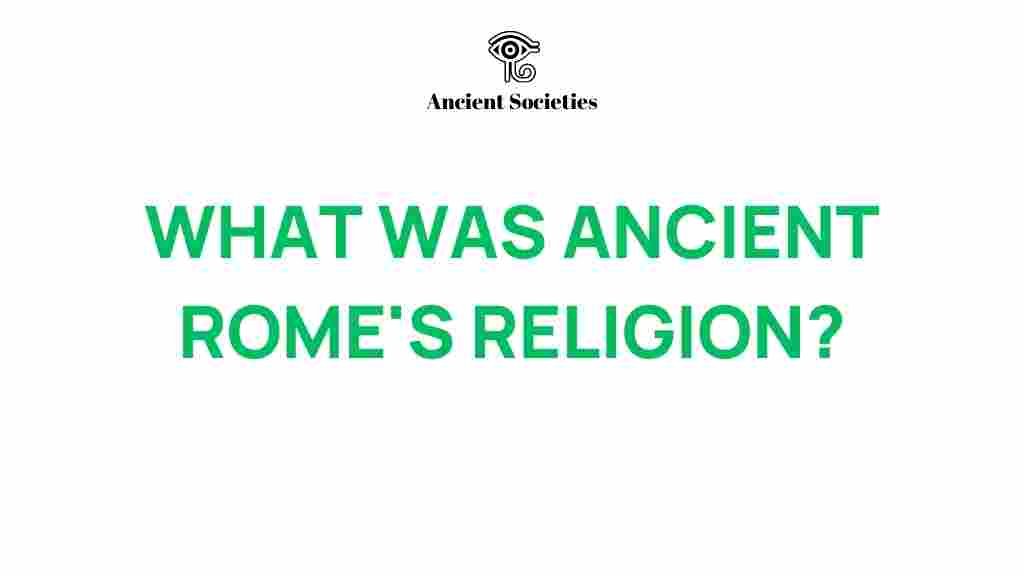Unveiling the Mysteries of Ancient Rome’s Enigmatic Religion
Ancient Rome, a civilization that thrived for over a millennium, is renowned for its remarkable achievements in governance, architecture, and culture. However, one of the most captivating aspects of this empire is its religion. The intricate tapestry of beliefs, rituals, and deities formed the backbone of Roman society and had a profound influence on its culture. In this article, we will delve into the various facets of Ancient Rome’s religion, exploring its mythology, deities, rituals, and the temples that housed their spirituality.
The Beliefs That Shaped a Civilization
The religion of Ancient Rome was polytheistic, meaning they worshipped multiple deities. Romans believed that these gods and goddesses could influence all aspects of life, from agriculture to warfare. The beliefs were deeply intertwined with the daily lives of the Romans, influencing everything from family dynamics to political decisions.
- Spiritual Connection: Romans felt a strong connection with the divine, believing that their actions could appease the gods and bring blessings.
- Rituals and Offerings: Regular rituals and offerings were made to maintain favor with the gods, highlighting the importance of religion in public and private life.
- Mythology: Myths served as stories to explain the origins of the world, the gods, and the moral lessons that guided Roman life.
Key Deities of Ancient Rome
The pantheon of Ancient Rome is vast and varied, with each deity embodying different aspects of life and nature. Below are some of the most significant deities:
- Jupiter: The king of the gods, associated with thunder and lightning, and protector of the state.
- Juno: The goddess of marriage and childbirth, often seen as the protector of women.
- Neptune: God of the sea, earthquakes, and horses, who played a crucial role in Roman naval power.
- Vesta: Goddess of the hearth, symbolizing home and family, with a sacred fire that was never allowed to go out.
- Mars: The god of war, revered by soldiers and associated with the protection of the city.
Rituals and Practices
Rituals were central to Ancient Roman religion, as they were believed to ensure the favor of the gods. These practices varied widely, from public ceremonies to private household offerings. Here are some prominent rituals:
- Public Festivals: Major festivals like Saturnalia celebrated the gods with feasting, games, and public events.
- Augury: The practice of interpreting the will of the gods by studying the flight patterns of birds.
- Sacrifices: Animals were often sacrificed to appease the gods, with the blood and offerings considered sacred.
Temples: The Heart of Roman Worship
Temples were sacred spaces where Romans could connect with their deities. They were often grand structures, adorned with intricate sculptures and inscriptions. Some of the most famous temples include:
- The Pantheon: A marvel of architecture, dedicated to all gods, showcasing the ingenuity of Roman engineering.
- The Temple of Jupiter Optimus Maximus: Located on the Capitoline Hill, it was one of the most important temples in Rome.
- The Temple of Vesta: A unique circular temple that housed the sacred flame tended by the Vestal Virgins.
Spirituality in Daily Life
Religion permeated every aspect of Roman life, with numerous rituals and customs that reflected their beliefs. The concept of *pax deorum* (peace of the gods) was vital, as Romans believed that maintaining the gods’ favor was essential to the state’s well-being.
- Household Worship: Families had household shrines (lararia) where they honored household gods (Lares and Penates).
- Ritual Calendar: The Roman calendar was filled with religious observances, ensuring that worship was a continuous part of life.
- Divination: Romans sought divine guidance through various methods, including reading omens and consulting oracles.
Influence of Greek Mythology
Ancient Rome’s religion was heavily influenced by Greek mythology. As the Romans encountered Greek culture, they adopted and adapted many Greek deities, often merging their attributes with Roman values. For example:
- Jupiter: Parallels with the Greek god Zeus, both serving as the chief deity and ruler of the gods.
- Venus: Corresponds to Aphrodite, embodying love and beauty.
- Mercury: The messenger god, akin to Hermes, known for his speed and cunning.
Religious Reforms and Changes
As Rome expanded, its religion evolved. The incorporation of various cultures and beliefs led to significant changes:
- Emperor Worship: With the rise of the Empire, emperors were often deified, creating a new form of worship.
- Syncretism: The blending of different religious practices and beliefs, leading to a more inclusive spiritual landscape.
Troubleshooting Common Misconceptions
Many misconceptions surround Ancient Roman religion. Here are some clarifications:
- Polytheism vs. Monotheism: While often viewed as primitive, polytheism allowed for a rich diversity of beliefs, adapting to new cultures as Rome expanded.
- Rituals as Mere Superstition: Rituals served as a means of social cohesion and reinforced community values, not just individual fear of divine wrath.
Conclusion
Ancient Rome’s religion was a complex and dynamic system that shaped the lives of its people. Through its myriad deities, rich mythology, and intricate rituals, Roman religion provided a framework for understanding the world. It served not only as a means of worship but also as a reflection of the culture and values that defined one of history’s greatest civilizations. As we continue to explore these ancient beliefs, we uncover the lasting impact they have had on modern spirituality and cultural practices.
For more on related topics, you can check this informative resource. To dive deeper into the fascinating world of Roman history, visit this site.
This article is in the category Culture and created by AncientSocieties Team
